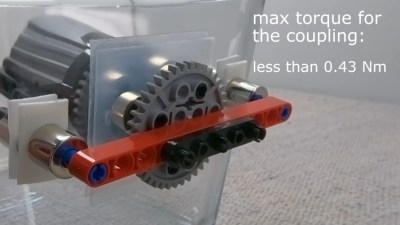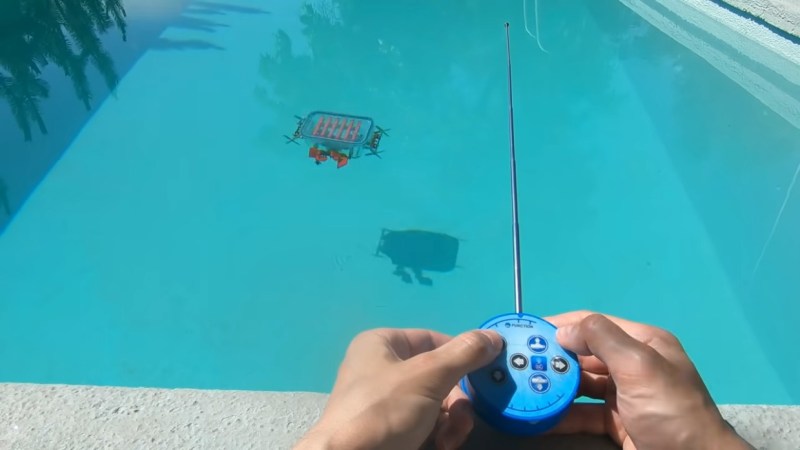Although you’d be hard-pressed to tell in some areas, it’s summer in the northern hemisphere, which always seems to bring out the projects that require a swimming pool for adequate testing. The [Brick Experiment Channel]’s latest build, a submersible made almost entirely from Lego, is one such project and has us pining for weather that makes a dip sensible rather than suicidal.
 The sub featured in the video below is a significant improvement over the “Sub in a Jug” approach the [Brick Experiment Channel] favored for version 1. Rather than starting with a vessel specifically designed not to hold water, the hull for this vessel is an IKEA food container, with a stout glass body and a flexible lid with silicone seals. And instead of penetrating the hull for driveshafts and attempting to seal them, this time around he built clever magnetic couplings.
The sub featured in the video below is a significant improvement over the “Sub in a Jug” approach the [Brick Experiment Channel] favored for version 1. Rather than starting with a vessel specifically designed not to hold water, the hull for this vessel is an IKEA food container, with a stout glass body and a flexible lid with silicone seals. And instead of penetrating the hull for driveshafts and attempting to seal them, this time around he built clever magnetic couplings.
The couplings transmit torque from the motors on the inside to gears and props on the outside. And where the first version used a syringe-pump ballast tank to control the depth, this one uses vertical thrusters. The flexible lid proved to be a problem with that scheme, since it tended to collapse as the depth increased, preventing the sub from surfacing. That was solved with some Lego bracing and adjustment of the lead shot ballast used to keep the sub neutrally buoyant.
This looks like a ton of summer fun, and even if you don’t have Legos galore to work with, it could easily be adapted to other materials. There are a ton of other fun [BEC] Lego builds to check out, some of which we’ve covered, including a Lego drone and a playing card shooter.
Thanks for the tip, [Vox]!
















Anyone who is hesitating to check out more videos on the channel, go for it. Especially if you’ve got kids, it is high quality educational content!
It is very crazy how legos can be used nowadays to build even the most complex of things. What will be next? strongest booter booter.su
Very good!
Next have a grapple arm!
(maybe one could 3D print more efficient dive thrust propellers)
I’m already surprised with how well those big blades he used actually work.
Lets face it, if he was going for efficiency, oval casseroles exist.
This is so incredibly cool. Avoiding the external connections with the magnetic coupling is awesome!
Fantastic! Maybe dip the magnets in poly varnish or similar. The slightest cut in the chrome coating and they turn into a blob of non-magnetic rust.
Well, that’s a cool Swedish submarine ;)
A cow-orker has previously mentioned that during an exercise in the Baltic Sea, a Swedish sub slipped undetected under the US Navy vessels.
That’s nothing. Soviet submarines have been lurking undetected in Swedish waters since the 1980’s.
https://en.wikipedia.org/wiki/Swedish_submarine_incidents
i’m impressed it works so well with the vertical thrusters being so far off the center line
It is sort of like the horse rider who only wore one spur…
He figured if he got one side of the horse moving faster, the other side would keep up.
This seems quite relevant:
https://hackaday.com/2020/04/13/simple-demo-shows-the-potential-of-magnetic-gears/
https://hackaday.com/2016/08/15/ask-hackaday-what-are-magnetic-gears-good-for/
Hey, this is a super rad project. We made this design almost exactly the same manner 2 years ago. https://learn.media.mit.edu/science/lego-wayfinder/ We needed a tether to have a camera feed to a laptop attached. Eventually we deployed a fleet of 10 of these near the Boston aquarium spotting all kinds of cool marine life around the docks.
Some remarks on the engineering: we got it to work with much simpler couplings with small magnets. The trick was to have proper propellors.